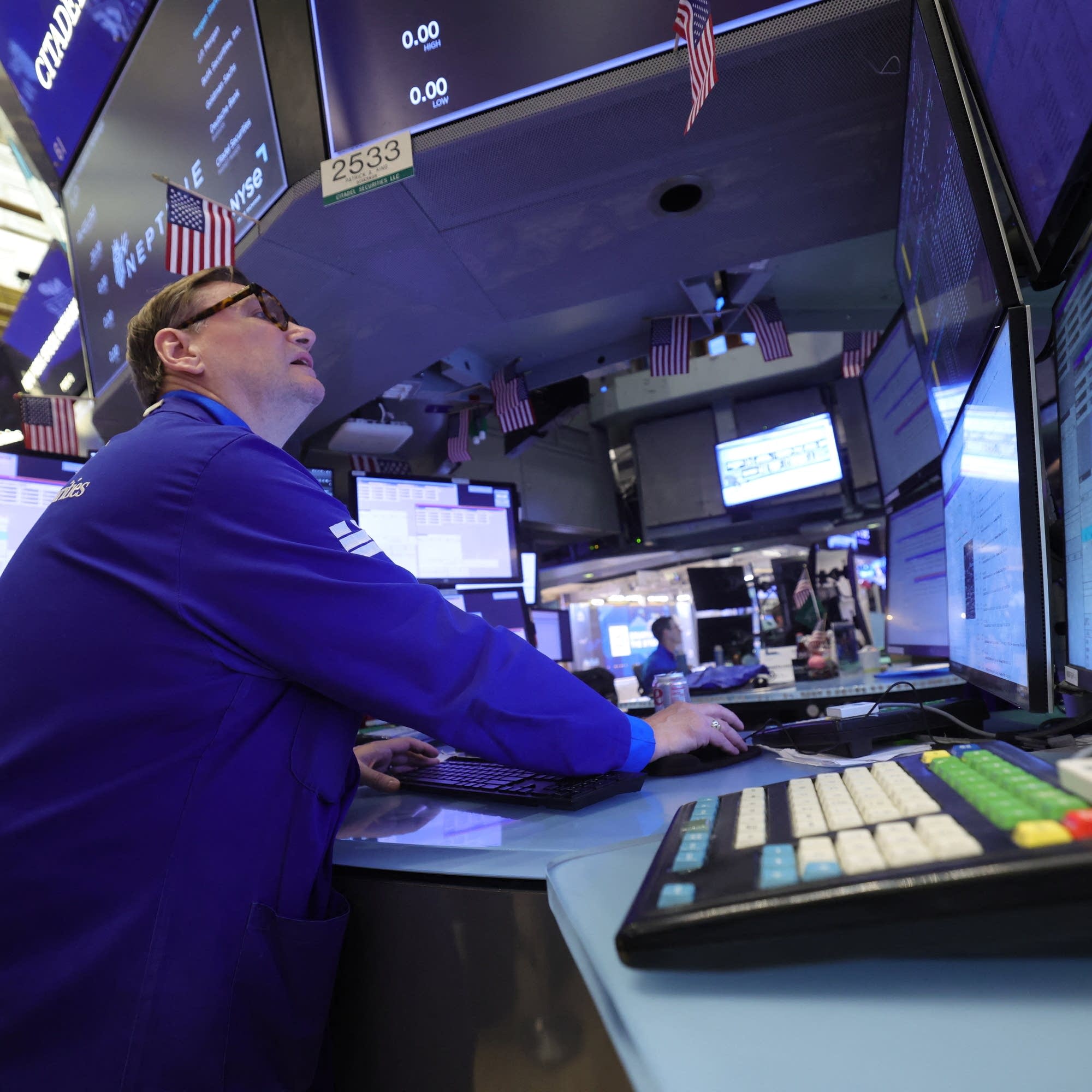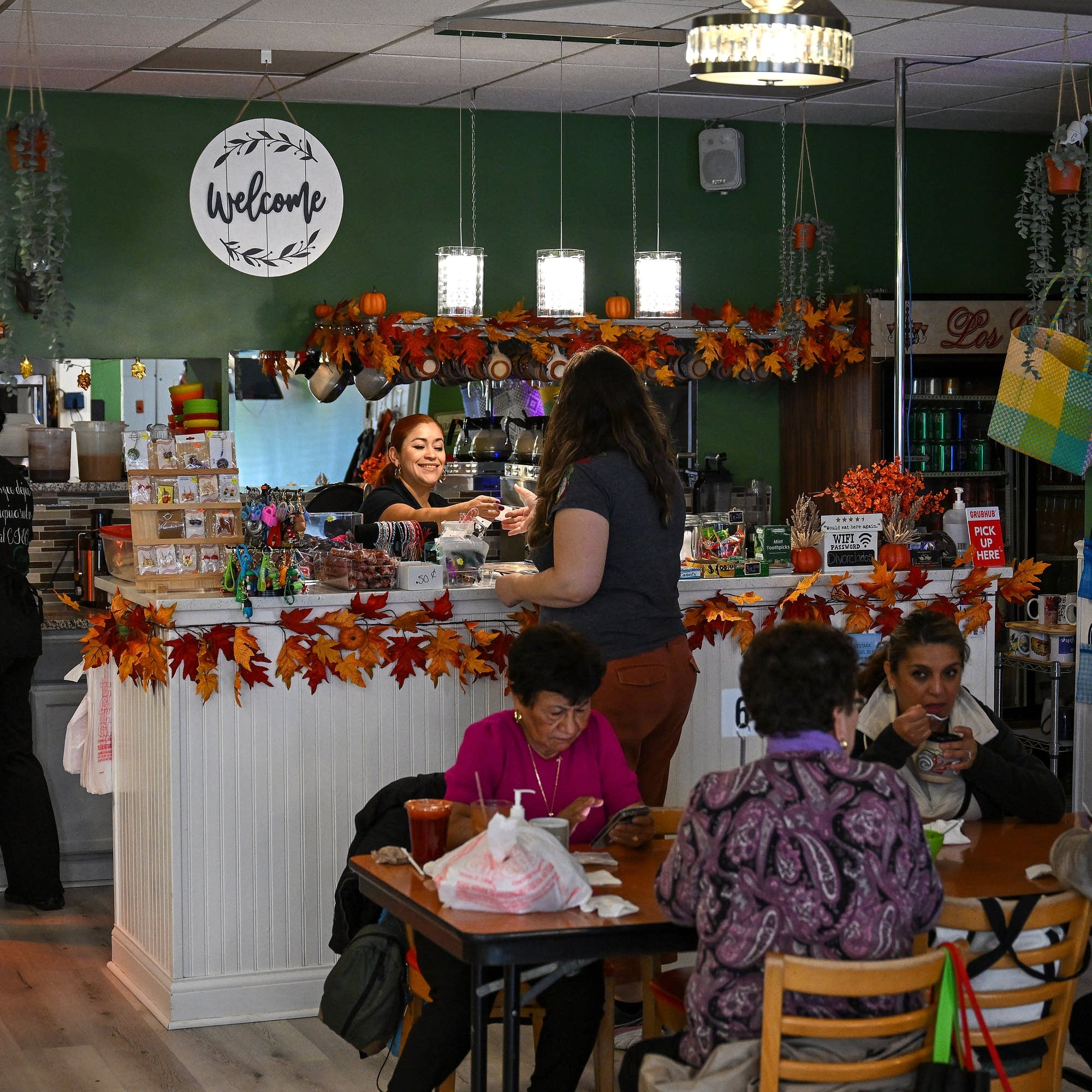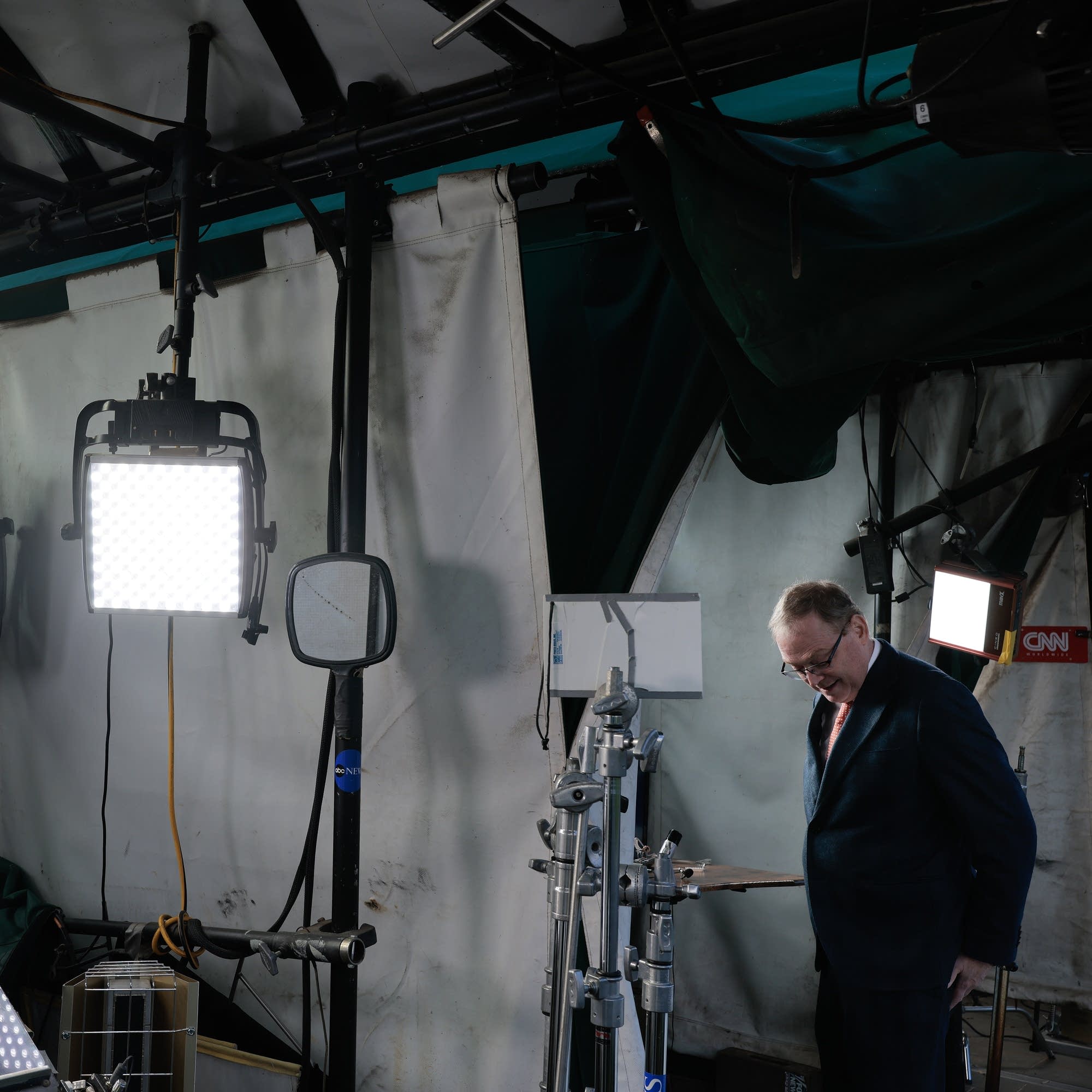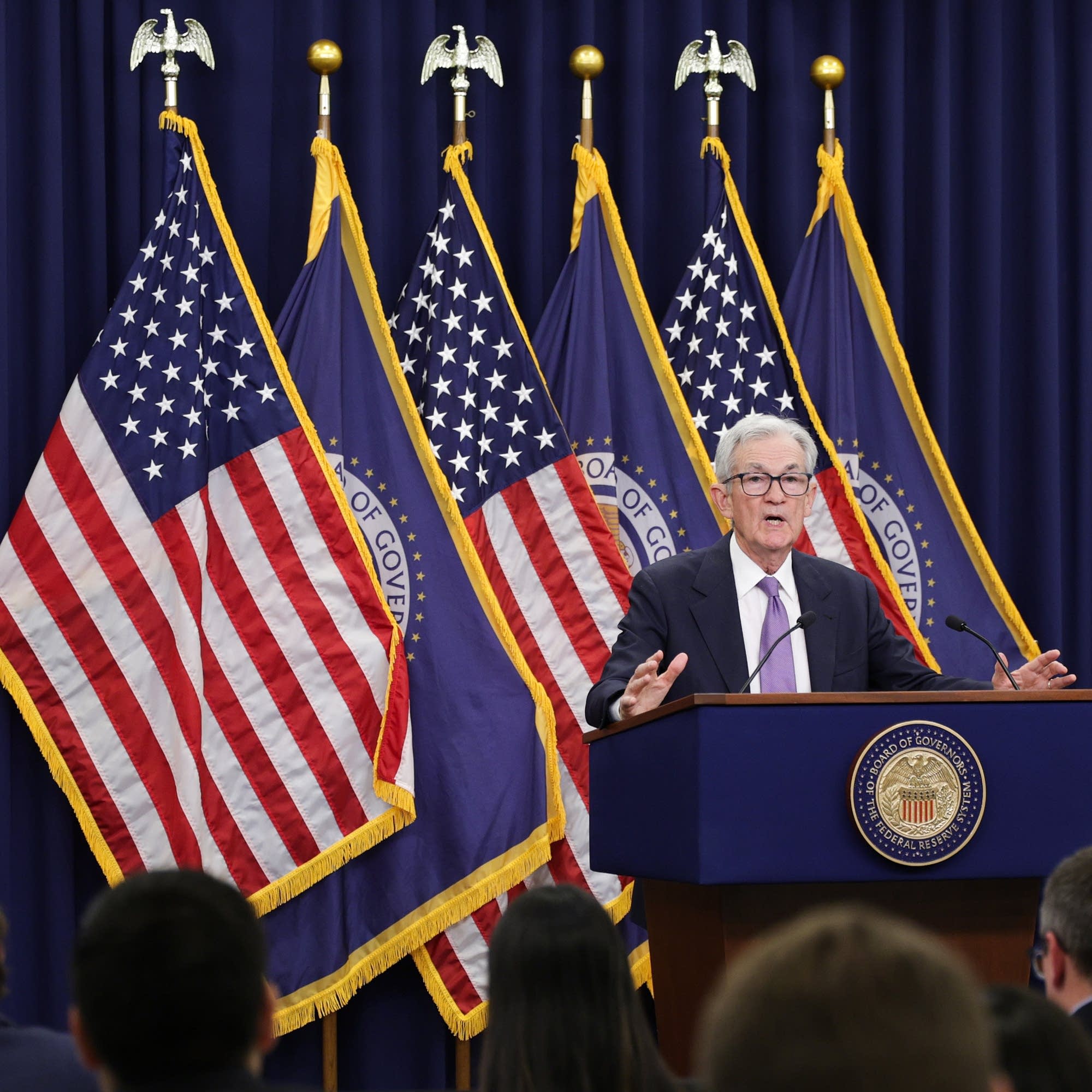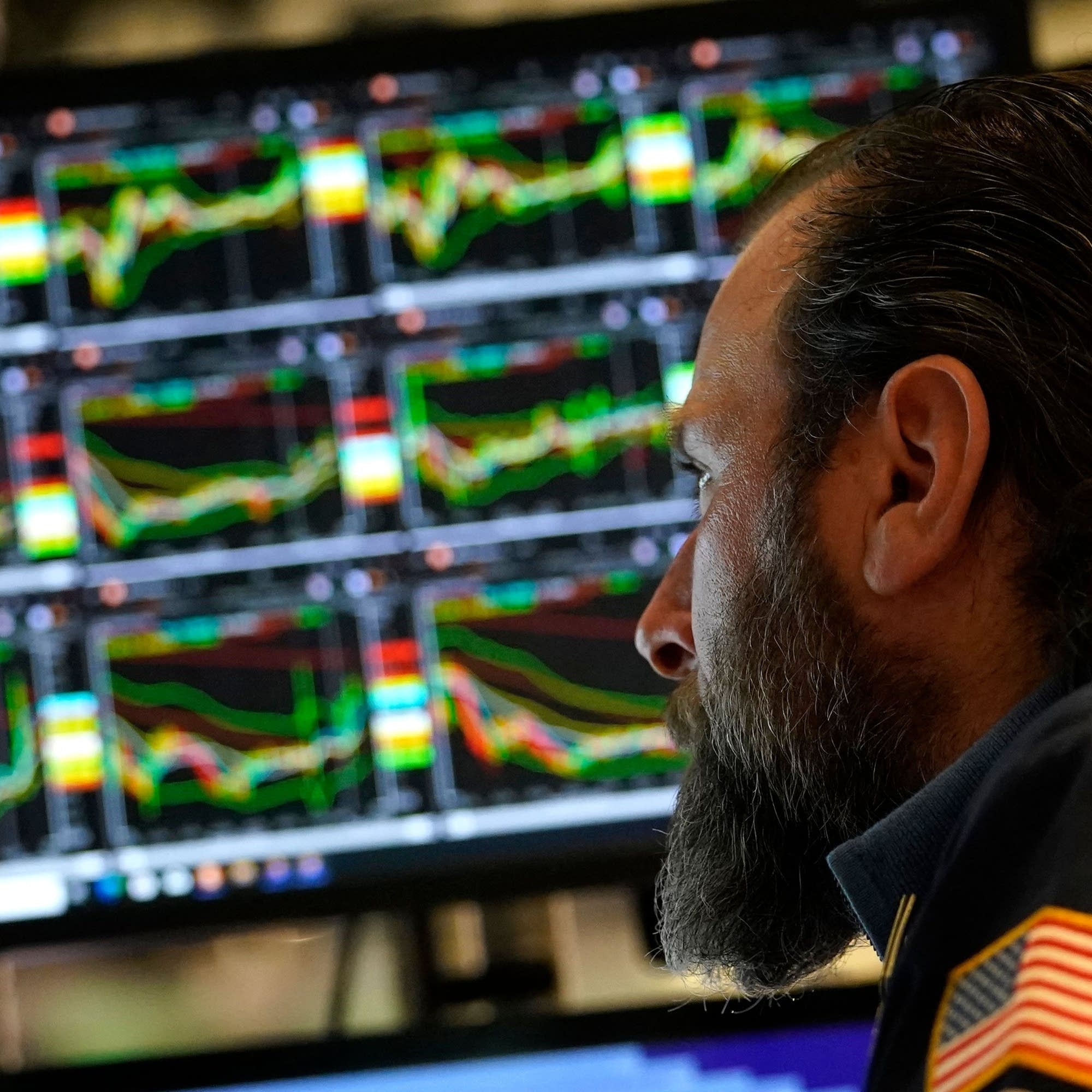Regional banks are doing alright, actually
Two midsize U.S. lenders claimed they were victims of loan fraud this week, sending bank stocks into a tailspin. But by close Friday, markets evened out — and for good reason: Regional banks, overall, are actually doing well. In this episode, we dispel the midsize bank sector doomsayers. Plus: Rising auto loan delinquencies could be a consumer debt canary in the coal mine, American culinary sensibilities have moved beyond “foodie” culture, and goats are the star employees in one family's landscaping business.
Every story has an economic angle. Want some in your inbox? Subscribe to our daily or weekly newsletter.
Marketplace is more than a radio show. Check out our original reporting and financial literacy content at marketplace.org — and consider making an investment in our future.
Press play and read along
Transcript
Speaker 1 This podcast is supported by Odoo. Some say Odoo business management software is like fertilizer for businesses because the simple, efficient software promotes growth.
Speaker 1 Others say Odoo is like a magic beanstalk because it scales with you and is magically affordable.
Speaker 3 And some describe Odoo's programs for manufacturing, accounting, and more as building blocks for creating a custom software suite.
Speaker 2 So Odo is fertilizer, magic beanstock building blocks for business.
Speaker 1
Odoo, exactly what businesses need. Sign up at odoo.com.
That's odoo.com.
Speaker 4
Recruitment. In finance, it can feel transactional, driven by numbers, not by nuance, lacking the personal touch that fuels performance.
LHH believes it should be more.
Speaker 4 By connecting people to opportunity, not just skills to roles.
Speaker 4
Beautiful things happen in finance. A leader drives growth.
A team finds clarity in complexity. The people you hire become the people you rely on, making 90,000 hours in a career well invested.
Speaker 4 Recruitment, development, career transition, LHH, a beautiful working world for the world of finance. Discover recruitment solutions today at LHH.com/slash beautiful.
Speaker 3 Funnily enough, the economy keeps going even when the government doesn't.
Speaker 3 From American public media, this is Marketplace.
Speaker 3
In Los Angeles, I'm Kyle Risdahl. It is Friday today, October the 17th.
Good as always to have you along, everybody.
Speaker 3 It's not a joke, you know, politicians going to politic, but the economy does not wait.
Speaker 3
So we're going to talk about where things are and where they might be going with Anna Swanson from the New York Times, also Greg Ipp from the the Wall Street Journal. Hey, you two.
Hey, Kai. Hey, Kai.
Speaker 3 Greg, we start with you, and I was going to start someplace, actually, but now I'm going to start with this. Without using the words shutdown or Federal Reserve,
Speaker 3 answer my question up at the top. Where is this economy right now?
Speaker 5 Oh, are you sure I can't say those words? You may not.
Speaker 3 You may not. It's my show, my rules.
Speaker 5 Last thing we heard was the economy was growing really well, like a 3% or 4% annual rate in the quarter that ended September 30th. But the weird thing is, is that the labor market was not.
Speaker 5
Employment was barely growing. And to the extent that we've had any information in the last few weeks, that's still kind of the picture that we have.
It's really kind of a strange two-speed economy.
Speaker 5 And whether you like the high-speed or the low-speed depends on which part of it you're on. If you have anything to do with artificial intelligence, or frankly, gold or crypto, you're doing great.
Speaker 5 But if you're out there looking for a job, you know, especially if you're a new graduate, things still look kind of rough out there.
Speaker 3 Ana, let me ask you about arguably the most important trading relationship in the world. Last week ended with China tariffs being promised, and then over the weekend they went away.
Speaker 3 Where do things stand between Washington and Beijing, and what do you expect?
Speaker 6 I mean, there's just a lot of uncertainty right now. So the president was threatening an additional 100% tariff on Chinese exports.
Speaker 6 They're already, you know, I think about a 55% tariff on Chinese exports. I mean, that's getting to a level that pretty much would just cut off trade between the countries.
Speaker 6 And that was in response to the Chinese putting in place this
Speaker 6 or proposing to put in place this licensing system for minerals that are really key to a bunch of global industries.
Speaker 6 So right now, there's a lot of nervousness and uncertainty about whether that will go forward.
Speaker 6 President Trump and Xi Jinping, the leader of China, are scheduled to meet in a couple of weeks, and it seems like it's all going to come down to this mano-a-mano meeting.
Speaker 6 Can the two leaders hash it out and what are the vibes but i think you know both countries simultaneously realize that this is this is a really bad path to go on and could be really harmful for both of them and yet there's still a lot of posturing and trying to get the other to back down so we'll really uh you know see what happens in the next couple weeks a let me stick with you for a second and this whole trade war thing that these two countries of which we are one uh have going on each of these countries has sort of domestic challenges, right, with consumers in both economies and the trade war sort of as covered.
Speaker 3 Do you suppose that they're kind of using that trade war to cover up for some of their internal challenges, right?
Speaker 3 The Chinese with their consumer economy, us with, you know, inflation and tariffs and all of that?
Speaker 6 Yeah, I think that is the case. I mean, you saw the Trump administration this week suggesting that this is another reason for the Fed to cut, that, you know, tensions with China, right?
Speaker 3 Well, it's a day that ends in Y, and that's why the Fed wants us to cut. It's another reason to cut.
Speaker 6 Definitely.
Speaker 6 But I do think that you have, you know, kind of each side
Speaker 6
with the U.S. and China looking at each other and assuming that domestic economic conditions are making the other side more vulnerable as well.
So in China, you have this serious property crisis.
Speaker 6 You know, so exports are certainly important with the property market being really weak.
Speaker 6 But on the other hand, the Chinese also believe that President Trump is vulnerable to the reaction from the stock market, as Greg's paper wrote this week, and businesses.
Speaker 6 So that feeds again into this game of chicken. Personally, I'm not sure it's a great idea to get into that kind of game of chicken with an authoritarian government that isn't as afraid of
Speaker 6 inflicting some pain on its own people if it feels like that's a good goal. But that is basically where we're at now.
Speaker 3 Amen to that one. I think that's probably wise advice.
Speaker 3 Greg, let me ask you, you had a super interesting column yesterday, the other day, about the speculation economy and where things stand right now.
Speaker 3 And it goes to the stock market, goes to the Fed, and I'd just like you to lay it out for folks.
Speaker 5 Yeah, sure.
Speaker 5 So everybody is like sort of just mesmerized by the boom going on in the markets right now, which is heavily driven by artificial intelligence and the so-called Magnificent Seven stocks, a lot of which are AI-related.
Speaker 5
You know, that's like 40% of the S ⁇ P 500, I think. It's like the most concentrated market in over 30 years, the IMF told us this week.
It's the second most overvalued market in 30 years.
Speaker 5 But what really strikes me is that the speculative fervor goes beyond the stock market. If you look in the bond market, the riskiest companies are borrowing at really low rates.
Speaker 5 We saw flare-ups of some of the consequences this week with bankruptcies of little known finance companies out there. But it's also like crypto.
Speaker 5 It's sports betting, you know, which is like growing 25% a year. And it's prediction markets.
Speaker 5 We saw the operator of the New York Stock Exchange take a stake in polymarket, where you can like bet on the World Series or the winner of the Nobel Peace Prize, valuing it at like $8 billion.
Speaker 5 And it feels to me like this speculation has now gone beyond the economy and it's like everywhere in our culture.
Speaker 5 And what's amazing is that the folks in Washington, they're not leaning against this speculation. They're kind of like fueling it.
Speaker 5 You know, the Trump administration is reducing regulations and the Federal Reserve is cutting interest rates. And I don't know how far it goes, but it sure is worth watching.
Speaker 3
Yeah, it sure is. Anas Wanson, last question to you, and it kind of goes like this.
I started with Greg and where this economy is now.
Speaker 3 Where do you think it goes, given the international trade tensions, given the domestic challenges that we just talked about? Now, where do things go?
Speaker 6 Yeah, well, I mean, it is a funny moment where, you know, everything's still kind of chugging along, but feeling more and more fragile.
Speaker 6 And it certainly doesn't help that we don't have official data at this point to really get a sense of how much we're at the turning point.
Speaker 6 But I do think you're hearing more from businesses about the effect of tariffs, about the effect of immigration policy, and concerns about that
Speaker 6 weighing on things.
Speaker 6 So I think there's just a lot of uncertainty from those policies,
Speaker 6 uncertainty from the lack of economic data.
Speaker 6 But yeah, that should generate a lot of concern right now.
Speaker 3 Greg, do you share that concern? You've got 30 seconds.
Speaker 5 I think that the economy is probably going to be okay. We don't have official data, but the private data we have tells us things are going to be okay.
Speaker 5 And it's hard for me to believe that the stock market can hit record after record and the Fed can cut interest rates and that it won't have some kind of positive effect.
Speaker 5 I suppose the one thing that does give me a pause is that every company seems to be talking about how they're going to use AI to cut jobs.
Speaker 5 And so what we might continue to see is this kind of split-screen economy where a lot of the things we think of as economy, like consumer spending, doing well, and yet people still very kind of concerned about the ability to get jobs.
Speaker 3 Greg Ipp at the Wall Street Journal, Anna Swanson, at the New York Times on a Friday. Thanks, you two.
Speaker 3 Thank you. Thanks.
Speaker 3
Wall Street for the day up a bit. For the week, less so.
We will have the details when we do the numbers.
Speaker 3 It's been a pretty dramatic couple of days for regional banks. I will spare you the stock market to and fro, but earlier this week, two of them disclosed lawsuits related to fraudulent loans.
Speaker 3 And a lot of regional banks have also been reporting earnings.
Speaker 3 Sabri was telling us a couple of days ago about how the big banks have been kind of raking it in, thanks mostly to their investment banking and trading businesses.
Speaker 3 Regionals, though, don't really do that kind of thing. This is not, I should say, at the moment, a repeat of the Silicon Valley bank implosion of 2023, if you remember that.
Speaker 3 But regional banks cannot be ignored. Marketplace Justin Ho has our primer.
Speaker 7 Regional banks are basically mid-sized banks that typically cater to mid-sized companies. Think the kind of businesses you might pass on the way to work.
Speaker 8
Distribution warehouses. It's going to be the companies that own the office buildings.
It's companies that are sizable, but but they're not an everyday brand name.
Speaker 7 That's Nate Tobik, CEO of Complete Bank Data.
Speaker 7 He says regional banks offer services to those companies that smaller lenders might not, including wealth management, tools that help companies with their day-to-day cash flows.
Speaker 7 Tobik says one line of business that's doing well lately is commercial lending. That's because commercial loans are typically renewed every few years.
Speaker 8 There's a lot of loans that were made back during COVID at historically low rates that are now resetting to market rates.
Speaker 7 Many of those loans are commercial real estate loans.
Speaker 7 Gerard Cassidy, a bank analyst at RBC Capital Markets, says commercial real estate borrowers have had some trouble in recent years, thanks in large part to work-from-home trends.
Speaker 9 There have been real issues in the downtown office space market, and we have seen defaults.
Speaker 7 But Cassidy says that's not necessarily a problem for regional lenders. That's because many of the toughest markets for commercial real estate are in big urban cities.
Speaker 9 So when you have a small regional bank in Nashville, Tennessee, they're not lending into the market in New York City or in San Francisco. They're lending into their local markets in Tennessee.
Speaker 7 And while some regional banks have reported credit losses in recent days, Cassidy says that's likely not a sign of wider trouble. He says credit quality across regional banks is generally strong.
Speaker 7 Julie Hill, Dean of the University of Wyoming College of Law, says if the Federal Reserve keeps cutting interest rates, regional lenders could get even stronger.
Speaker 10 First, that'll make it so that banks don't have to pay as much money to attract deposits, but it'll also spur some demand for borrowing.
Speaker 7 But Hill says all of that depends on the outlook for the economy. Right now, that outlook's pretty murky.
Speaker 10 And so anytime you introduce uncertainty, it makes banks nervous about lending, nervous about overextending.
Speaker 7 A report out this week from the Federal Reserve found that many lenders and borrowers are feeling cautious. I'm Justin Hubb for Marketplace.
Speaker 3
All right, we're going to do a little more lending now, auto lending to be particular. Car loans are a good bet for lenders.
People make their car payments. It's as simple as that.
Speaker 3 But there is some new data out from VantageScore showing that over the past 15 or so years, auto loan delinquencies have risen by 50%.
Speaker 3 And therein, as Marketplace's Carl Javier reports, lie signals of deeper consumer trouble.
Speaker 11 Right after the Great Recession, auto loans were among the safest out there, says Ricard Bandibo, chief economist at VantageScore. But these days...
Speaker 12 In 2025 now, we saw for the first time that auto loans were the riskiest product, excluding student loans.
Speaker 11 And it's not just lower income consumers falling 60 or more days behind on car payments.
Speaker 12 We basically saw that the increase in delinquencies was consistent, low income, middle income, and higher income.
Speaker 11
One reason, car ownership is more expensive. Sticker prices are way up, and so are maintenance and insurance.
Plus, Americans are buying bigger cars with more fancy stuff.
Speaker 13 The bigger trucks, the bigger SUVs with all the amenities.
Speaker 11 That's Jessica Caldwell, head of insights at the car buying site Edmonds.
Speaker 13 And now there's not a lot of low-end type vehicles.
Speaker 11 Caldwell says in September, the average price of a new vehicle was more than $49,000. Factor in high interest rates and the average monthly payment is $760.
Speaker 3 That's a pretty hefty chunk.
Speaker 13 And if we rewind time and went back to 2019 around this time, it was about $550.
Speaker 11 MIT professor Christopher Palmer studies household debt. He says defaulting on a car payment is usually a borrower's last resort, since people often need cars to get to work.
Speaker 11 So they're more likely to not pay other bills first.
Speaker 14 That could include not paying their mortgages or their rent in part because it takes a long time to evict someone or to foreclose on a house.
Speaker 11 Compared to cars, which he says can be repossessed relatively quickly. That's why he says auto-delinquencies are like a canary in the coal mine, another indicator of how squeezed consumers are.
Speaker 11 I'm Carla Javier for Marketplace.
Speaker 3 Coming up.
Speaker 15 We fell in love with the goats.
Speaker 3 Whatever it takes, I guess. First, though, let's do the numbers.
Speaker 3 Dow Industrial is up 238 points, about a half a percent, 46,190 for the blue chips. The NASDAQ climbed 117 points, that's a half percent, 22,679.
Speaker 3 The SP 500 gained 34 points, half a percent, 66, and 64.
Speaker 3 For the five days gone by, the Dow picked up 1.6%. The NASDAQ rose 2.10%.
Speaker 3 S P 500 added 1.7%.
Speaker 3 That AI infrastructure building boom that's helping to prop up this economy right now, Greg Ipp just talked about that.
Speaker 3 Goldman Sachs reportedly wants a bigger piece of it, according to a piece in the Wall Street Journal. The bank is creating a team that would focus on financing data centers and other AI projects.
Speaker 3
Goldman, however, gave back 1% today. Carlo was just telling us about auto loans.
Auto Lender Ally Financial beat profit expectations for the quarter, pocketed 3.6% today.
Speaker 3 The bank, formerly known as Bank of the Ozarks, reported a record profit for the third quarter, but still managed to fall short of analyst expectations.
Speaker 3 Bank OZK, as it it is now officially known, slid 2.25%. Bonds down, yield on the 10-year T-note up 4.01%.
Speaker 3 You are listening to Marketplace.
Speaker 3 This Marketplace podcast is sponsored by the University of Illinois Geese College of Business. For many, the next step in their career is an MBA, but finding the time and budget can be a challenge.
Speaker 3 The University of Illinois Geese College of Business offers their online MBA, the IMBA. It's fully online, flexible, and delivered at a fraction of the cost of a traditional MBA.
Speaker 3 Students get the same world-class Illinois faculty and an interactive global network all designed to fit their lives. To learn more about about the Geese IMBA, visit onlinemba.illinois.edu.
Speaker 3 That's onlinemba.illinois.edu.
Speaker 16 This marketplace podcast is supported by Justin Wine. Get the celebration ready with Justin Wine.
Speaker 16 Since 1981, Justin has been producing world-class Bordeaux-style wines from Paso Robles on California's Central Coast.
Speaker 16 Justin offers curated gift sets, library wines, magnums, and even custom-etched bottles. Visit JustinWine.com and enter Market 20 for 20% off your order.
Speaker 16 Justin offers the perfect holiday gifts for clients, colleagues, friends, or family. Be sure to check them out at justinwine.com to receive 20% off your order for a limited time.
Speaker 4 Fifth Third Bank's commercial payments are fast and efficient. But they're not just fast and efficient, they're also powered by the latest in payments technology built to evolve with your business.
Speaker 4 Fifth Third Bank has the Big Bank Muscle to handle payments for businesses of any size, but they also have the FinTech Hustle that got them named one of America's most innovative companies by Fortune magazine.
Speaker 4 That's what being a Fifth Third Better is all about. It's not about being just one thing, but many things for our customers.
Speaker 4 Big Bank Muscle, FinTech Hustle, that's your commercial payments, a fifth third better.
Speaker 17 Imagine if today was the day your idea changed someone's life.
Speaker 17 Imagine if you could help someone pay for college, help your community build a new playground, or help a child make it to that dream competition. With GoFundMe, it's all possible.
Speaker 17
GoFundMe is the world's number one fundraising platform trusted by over 190 million people. Every week, ordinary people meet their goals and do extraordinary things.
Your ideas matter.
Speaker 17 GoFundMe isn't just for emergencies. Want to raise money for your kids' soccer team or raise funds for a small business, a creative project or event?
Speaker 17
GoFundMe helps you turn ideas into reality and help adds up. Fundraisers you start for someone else raise up to five times more.
So think right now, who could use your help?
Speaker 17
Change rarely comes from waiting. It comes from someone deciding, today I'll start.
Don't wait for someone else to bring change. Today, start your fundraiser in just minutes at gofundme.com.
Speaker 17
That's gofundme.com to start your fundraiser. GofundMe.com.
This is a commercial message brought to you by GoFundMe.
Speaker 3
This is Marketplace. I'm Kai Rizdahl.
Where are you on the foodie spectrum? Do you just eat and you're satisfied? Do you perhaps dabble in flavors and textures from time to time?
Speaker 3 Or do you go all in, handmade pumpkin ravioli, maybe, or bison bacon? Whichever best describes it you, foodie culture in this economy ain't what it used to be.
Speaker 3
Jaya Saxena has a piece in Eater magazine. It's called The Life and Death of the American Foodie.
Welcome to the program.
Speaker 18 Hi, thanks for having me.
Speaker 3
So here we are. You've written a totally fascinating piece.
There's history in here and pop culture and all of this stuff. And
Speaker 3 I'm going to characterize it and I need you to either correct me or roll with it.
Speaker 3 Wonderful. The gist of this thing is
Speaker 3 we are all foodies now, basically, right?
Speaker 18 Yes. We are sort of living in the era of the foodie, such that the word foodie sort of doesn't even matter anymore.
Speaker 3 That doesn't describe. It's almost pejorative, actually, right? It's almost pejorative.
Speaker 18
Yeah. Oh, yeah.
But I think it kind of doesn't matter now because it's describing a behavior that the vast majority of us engage in in one way or another.
Speaker 18 So there's sort of no reason to call it out anymore.
Speaker 3
And so we're all foodies, but there are people who now make their living. There are the influencers on Instagram and there are writers and all kinds of people who make their living as foodies.
And
Speaker 3 it's a career path.
Speaker 18 Absolutely.
Speaker 18 I think one of the big things that's happened in the past 20 or so years is that there are just more ways than ever to engage with food as a culture without actually having to engage with food itself.
Speaker 18
You can watch food television. You can watch TikTok.
You can watch YouTube videos. You never have to go to a restaurant.
You never have to cook any of those meals yourself.
Speaker 18 You can engage with this purely as entertainment.
Speaker 3 Yeah, there's also a diversity thing that comes into play here, right? Because while foodie-ism
Speaker 3 in its origins, right, Juliet Chowd and Jacques Pepin, you know, all those other, okay, I'm going to say it, older white people, right? We now can,
Speaker 3 through, you know, shows like Top Chef and Iron Chef, and then now all these Instagram people, we can get all kinds of different foods on our phones and on our plates.
Speaker 18
Exactly. I think there's been a great democratization of information and knowledge.
I mean, the way that the internet has sort of provided about lots of different topics.
Speaker 18 But with food, you do not have to keep only the knowledge of maybe your people and your culture. And I think specifically in the US, there's been a lot of writing about the global pantry.
Speaker 18 I think about how my grandmother, who is from India, used to have to travel from New Jersey into New York in order to get turmeric at the one store that she knew that sold it.
Speaker 18 And now I can go to any grocery store near me and buy that. And that is no longer quote unquote an exotic product.
Speaker 18 And so I think that just the kinds of ingredients available to us and then the information about what to do with those ingredients allows anybody to really cook or eat anything.
Speaker 3 Trevor Burrus, Jr.: See, now that answer makes me turn to the marketplace of this whole thing.
Speaker 3 And I hate to do this to you, but I got to, no, I got to bring like the news and current events into this.
Speaker 3 The internationalization of food culture in the United States now is being affected by tariff and trade policy.
Speaker 3 You talk to a bartender who's working on cocktails that don't use citrus because limes are too expensive because of tariffs? I mean, come on.
Speaker 13 Yeah, absolutely.
Speaker 18 And, you know, some of this because obviously the tariff seems so up in the air and changing day to day, but a lot of suppliers and distributors are preemptively charging more.
Speaker 18 And already, you know, I've seen certain restaurants close because they're of certain cuisines, I think specifically a lot of Asian cuisines, saying that the ingredients that are the foundation of our restaurant, these are not things that can be grown domestically.
Speaker 18
There's no domestic cinnamon production in the U.S. We are not the climate for it.
So, you know, there are a lot of places where things are just getting too expensive to operate.
Speaker 3 Last question, and then we got to go.
Speaker 3 Are you a doer or are you a looker? Do you scroll Instagram or do you go and actually make the foods and eat the foods and buy the foods?
Speaker 18
Oh, I do both, but I'm definitely a doer. I am somebody who loves to cook, loves to try new things.
Yeah, one of the great joys of my life.
Speaker 3
Jaya Saxena, she's a food writer all over the place. Eater is where this piece is.
It's a really good piece. Jaya, thanks a lot.
I appreciate your time.
Speaker 18 Thank you so much.
Speaker 3 Farming in this economy isn't just one thing.
Speaker 3
You got farmers who grow crops, wheat and soybeans, corn, what have you. You got farmers who raise livestock, cows and pigs mostly.
And then you got farmers who farm with a side hustle.
Speaker 3 That brings me to today's installment of our series, My Economy.
Speaker 15 My name is Aaron Steele. I am a co-founder of Goats on the Go, based in Ames, Iowa.
Speaker 15
In 2012, my family had moved to a little country place. It's a few acres in size.
Three acres was too much for us to want to mow.
Speaker 15 So our three young sons could use some chores to do during their summer vacation anyway. So we decided we would get a handful of goats.
Speaker 15 The plan was to get them in the spring, sell them in the fall, not have to worry about them through the winter. But we fell in love with the goats.
Speaker 15 We got to observe firsthand what they were capable of in terms of eating weeds and brush.
Speaker 15 And we just started thinking of ways to grow our own little farm and extend this service of weed and brush control with goats to other people.
Speaker 15 The first step in determining if goats are right for a customer in their property is to see do you have the vegetation that is ideal for goats, which tends to be different than what we would think of sheep and cattle that tend to eat more grasses, whereas the goats really have a preference for tall, broad-leafed weeds and woody vegetation.
Speaker 15 And it's got to be of a size that matters. If it's quarter acre, half an acre, or larger, that's the sort of thing that we love to do.
Speaker 15 The benefits are really threefold. One, some of the vegetation that we're called on to address are invasive plants.
Speaker 15 And so Traditionally, the best ways to deal with invasive vegetation are chemical herbicides and motorized equipment.
Speaker 15 And by using goats, we get to address that invasive species problem while offsetting the use of chemical herbicides.
Speaker 15 Then on top of that, we impact the quality of the soil that the goats are grazing on. They leave fertilizer behind, obviously, and just the action of grazing can have real benefits for the soil.
Speaker 15 And in the western U.S., The real demand for goats is coming from wildfire mitigation.
Speaker 15 We need to get in there with goats and sometimes sheep to consume all of this excess vegetation that could just serve as fuel in a wildfire situation.
Speaker 15 Finding good labor at an affordable price is a challenge.
Speaker 15 Transportation is a challenge and the cost of trucking, just like every other product and service that anyone is buying these days, the cost keeps going up.
Speaker 15 This really came about because of those three young sons of mine that needed some chores to do in the summer.
Speaker 15 It is my hope that one or more of them will be interested in taking over the operation at some point.
Speaker 15 We'll wait and see.
Speaker 15 But even if they don't, even if it ends up not being their thing, I think that they've learned an awful lot about life and about business and about the food we eat and the land we live on.
Speaker 3
Aaron Steele in Ames, Iowa. This series does not get done without you.
So write to us, would you? Let us know what's going on. Marketplace.org slash my economy.
Speaker 3 This final note on the way out today, in which I am obliged by,
Speaker 3 well, you know, fact.
Speaker 3
To tell you once again that it's American companies and consumers that are paying President Trump's tariffs. And boy are they, saw this in Axios.
Data this week from S ⁇ P Global that U.S.
Speaker 3 businesses are now thinking they're going to wind up paying $1.2 trillion more in expenses this year than they had been expecting back on New Year's Day.
Speaker 3 To be clear, that's not a trillion more in tariffs. It's a trillion more in overall expenses because of the drag of those tariffs, supply chain disruptions, and all the rest of this stuff.
Speaker 3
The bulk of that trillion, S ⁇ P says, is going to be passed on to consumers. I'm going to say it one more time.
Tariffs are taxes paid by American American consumers and American businesses.
Speaker 3 Our theme music was composed by BJ Lederman Marketplace's executive producer Nancy Fargali. Joanne Griffith is the Chief Content Officer Neil Scarborough's Vice President and General Manager.
Speaker 3
And I'm Kyle Rizdah. Have yourselves a great weekend, everybody.
We will see you back here on Monday. All right.
Speaker 3 This is APM.
Speaker 19 How did we go from free-range chicken and grass-fed beef to lab-grown meat?
Speaker 21 It's just this very simple notion
Speaker 21 that basically the animals that we eat are using an awful lot of the earth.
Speaker 21 And it's one of those things that once you see it, you can't unsee it.
Speaker 20 I'm Amy Scott, and this week on How We Survive, we traveled to San Francisco to meet someone who went from growing human heart cells to producing cell-cultivated salmon.
Speaker 19 Could it be the future of meat?
Speaker 20 Listen to How We Survive on your favorite podcast app.
